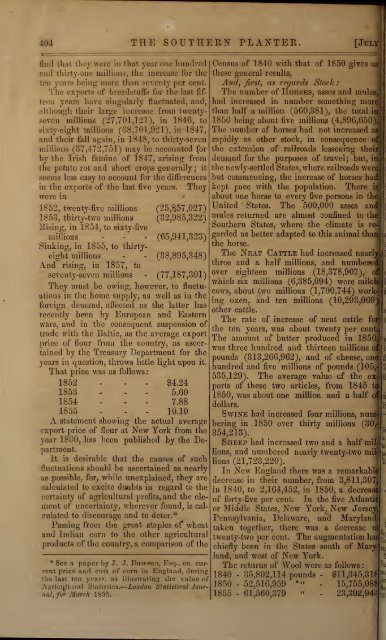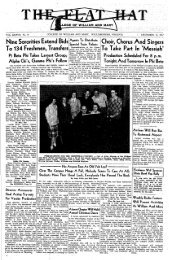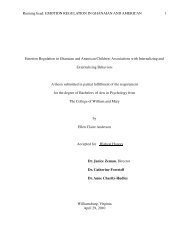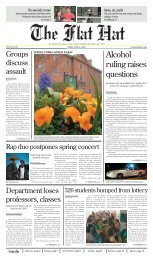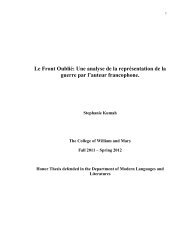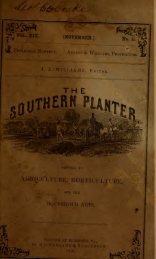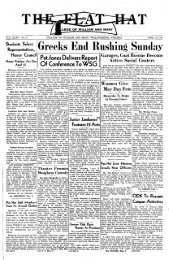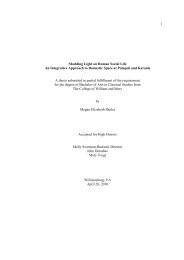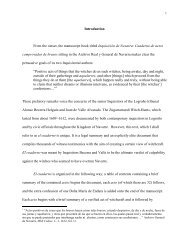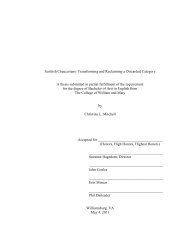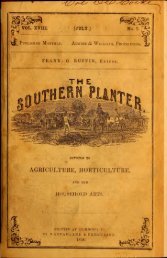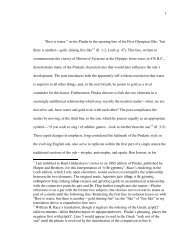Southern planter - The W&M Digital Archive
Southern planter - The W&M Digital Archive
Southern planter - The W&M Digital Archive
You also want an ePaper? Increase the reach of your titles
YUMPU automatically turns print PDFs into web optimized ePapers that Google loves.
404 THE SOUTHERN PLANTER [July<br />
find that they were in that year one hundred<br />
and thirty-one millions, the increase for the<br />
ten years being more than seventy per cent.<br />
<strong>The</strong> exports of breadstuff's For the last fifteen<br />
years have singularly fluctuated, and,<br />
although their large increase from twentyseven<br />
millions (27,701,121), in 1846, to<br />
sixty-eight millions (68,701,921), in 1847,<br />
and their fall again, in 1848, to thirty-seven<br />
millions (37,472,761) may be accounted for<br />
by the Irish famine of 1847, arising from<br />
the potato rot and short crops generally ; it<br />
seems less easy to account for the differences<br />
in the exports of the last five years. <strong>The</strong>y<br />
were in<br />
1852, twenty-five millions (25,^57,027)<br />
1853, thirty-two millions (32,985,322)<br />
Rising, in 1854, to sixty-five<br />
millions - - - (65,941,323)<br />
Sinking, in 1855, to thirty-<br />
eight millions - - (38,895,348)<br />
And rising, in 1857, to<br />
seventy-seven millions - (77,187,301)<br />
<strong>The</strong>y must be owing, however, to fluctu-<br />
ations in the home supply, as well as in the<br />
foreign demand, affected . as the latter has<br />
recently been by European and Eastern<br />
wars, and in the consequent suspension of<br />
trade with the Baltic, as the average export<br />
price of flour from the country, as ascer-<br />
tained by the Treasury Department for the<br />
years in question, throws little light upon it.<br />
That price was as follows<br />
1852 - - - $4.24<br />
1853 - - - 5.60<br />
1854 - - - 7.88<br />
1855 - - - 10.10<br />
A statement showing the actual average<br />
export price of flour at New York from the<br />
year 1800, has been published by the Department.<br />
It is desirable that the causes of such<br />
fluctuations should be ascertained as nearly<br />
as possible, for, while unexplained, they are<br />
calculated to excite doubts in regard to the<br />
certainty of agricultural profits, and the element<br />
of uncertainty, wherever found, is cal-<br />
culated to discourage and to deter.*<br />
Passing from the great staples of wheat<br />
and Indian corn to the other agricultural<br />
products of the country, a comparison of the<br />
* See a paper by J. J. Dawson, Esq.. on current<br />
price and cost of corn in England, dnring<br />
the last ten year.-', as illustrating the value of<br />
iiltiiial Statistics. London Statistical Jour<br />
nal,for March 1855.<br />
Census of 1840 with that of 1850 gives us<br />
these general results,<br />
And, jirsf, as regards Stock<br />
<strong>The</strong> number of Horses, asses and mules,<br />
had increased in number something more<br />
than half a million (560,381), the total in<br />
1850 being about five millions (4,896,650).<br />
<strong>The</strong> number of horses had not increased as<br />
rapidly as other stock, in consequence of<br />
the extension of railroads lessening their<br />
demand for the purposes of travel; but, inj<br />
the newly-settled States, where railroads wer<br />
but commencing, the increase of horses had<br />
kept pace with the population. <strong>The</strong>re i<br />
about one horse to every five persons in the:<br />
United States. <strong>The</strong> 500,000 asses and<br />
mules returned are almost confined to th<br />
<strong>Southern</strong> States, where the climate is re<br />
garded as better adapted to this animal tha<br />
the horse.<br />
<strong>The</strong> Neat Cattle had increased nearly|<br />
three and a half millions, and numbered<br />
over eighteen millions (18,378,907), of<br />
which six millions (6,385,094) were milch<<br />
cows, about two millions (1,700,744) work-^<br />
ing oxen, and ten millions (10,293,069)]<br />
other cattle.<br />
<strong>The</strong> rate of increase of neat cattle for]<br />
the ten years, was about twenty per cent.]<br />
<strong>The</strong> amount of butter produced in 1850,'<br />
was three hundred and thirteen millions of<br />
pounds (313,266,962), and of cheese, one<br />
hundred and five millions of pounds (105,-<br />
535,129). <strong>The</strong> average value of the ex-'<br />
ports of these two articles,<br />
1850, w<br />
from 1845<br />
a half 5<br />
Tas about one million and<br />
dollars.<br />
Swine had increased four millions, numbering<br />
in 1850 over thirty millions (30,-<br />
354,213).<br />
Sheep had increased two and a half mil-<br />
lions, and numbered nearly twenty-two mil-<br />
lions (21,723,220).<br />
In New England there was a remarkabh<br />
decrease in their number, from 3,811,307<br />
in 1840, to 2,164,452, in 1850, a decrease<br />
of forty-five per cent. In the five Atlantic<br />
or Middle States, New York, New Jersey^<br />
Pennsylvania, Delaware, and Maryland,<br />
taken together, there was a decrease oj<br />
twenty-two per cent. <strong>The</strong> augmentation h<br />
chiefly been in the States south of Mary'<br />
land, and west of New York.<br />
<strong>The</strong> returns of Wool were as follows<br />
1840 - 35,802,114 pounds - $11,345,31*<br />
1850 - 52,516,959<br />
m « - 15,755,08*<br />
1855 - 61,560,379 23,392,944<br />
i:


